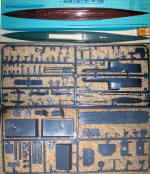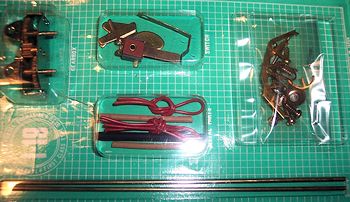
Nichimo 1/200 Japanese Type Otsu Submarine I-19
| KIT #: | U-2006 |
| PRICE: | $26.00 in the 90’s (kit now OOP) |
| DECALS: | One option |
| REVIEWER: | Ray Mehlberger |
| NOTES: | Motorized |

| HISTORY |
When the London Treaty was scrapped in 1937, the Japanese Navy carried out a shipbuilding program which was called the “Maru San” program. Battleships of the world-famous “Yamato” class, aircraft carriers of the “Shikaku” class and advanced ships of other types were built one after another. As restrictions on size was lifted, greater power was demanded of submarines. They needed to possess a greater activity range, for joint activities with the main body of the fleet and a higher surface cruising speed. This was specified in the “Kadai” model, which was a large sized submarine specified for the navy. The following three types were designed from the point of view of strategy:
The “I-19” model belongs to the type B. Construction of this type of submarine was started at the Mitsubishi Kobe Dockyard in March 1938. The first one was launched in 1939. It still needed some completion work, so didn’t get delivered to the Japanese Navy until May 31, 1941.
In actual operation, this submarine proved to have excellent performance. A total of 29 of the type B submarines were built. They were numbered in a rather odd numerical order:
I-15, I-17, I-19, I-21, I-23, I-25, I-26, I-27, I-28, I-29, I-30, I-31, I-32, I-33, I-34, I-35, I-36, I-37, I-38, I-39.
Only one survived the war. It was I-36.
I-19 achieved considerable success on Sept. 15, 1942 when she fired six torpedoes at the aircraft carrier USS Wasp. Two of these hit the carrier forward and ignited gasoline storage, dooming the ship. The remaining four torpedoes of this salvo went several thousand yards further and encountered a second American carrier task force, damaging the battleship USS North Carolina enough to require two months to repair, and sinking the destroyer USS O’Brien. This was one of the most damaging torpedo salvoes in history.
It is believed that the I-19 was lost to attack by US Navy aircraft on Oct. 18, 1943.
| THE KIT |
 The
kit comes in a 22” long, tray and lid type box. The box contains two medium gray
parts trees (each in cello bags), the full hull bottom (molded in bright red and
fitted into an inverted tray with the center cut out to accept the hull part),
the upper deck (molded in medium gray and placed in a aperture next to the hull
holding tray), motorization hardware (in a blister pack and stapled to the side
of the box), a Baby Mabuchi RE-260 electric motor, the decal sheet, the
instructions and a separate sheet of the parts tree drawings. There is also a
card with three color patches on it, also stapled to the box side.
The
kit comes in a 22” long, tray and lid type box. The box contains two medium gray
parts trees (each in cello bags), the full hull bottom (molded in bright red and
fitted into an inverted tray with the center cut out to accept the hull part),
the upper deck (molded in medium gray and placed in a aperture next to the hull
holding tray), motorization hardware (in a blister pack and stapled to the side
of the box), a Baby Mabuchi RE-260 electric motor, the decal sheet, the
instructions and a separate sheet of the parts tree drawings. There is also a
card with three color patches on it, also stapled to the box side.
The instructions consist of a single large sheet that is accordion folded to fit the box. It gives six assembly steps and is all in Japanese. About half of the steps are used for motorizing the model, if you so choose to do so.
The separate long sheet has the parts tree drawings on it, but does not have illustrations of the bottom hull or deck pieces. It calls out what the parts are on these trees in Japanese only. A list to the side apparently is listing the hull and deck part and all the motorization hardware in Japanese too.
The decal sheet
contains Japanese flags, in both the types of with or without the rays emanating
from the red ball center and “I” numbers to put on the conning tower. This decal
sheet is very ODD. The images are printed on it FACE-DOWN and they feel sticky
to the touch. They are covered with a protective sheet. I cannot determine if
they are some kind of a rub-on, dry transfer or you wet them to use them? The
 instructions
that are all in Japanese do not help.
instructions
that are all in Japanese do not help.
The first parts tree holds: the conning tower halves and floor, rudder, cranes, Glen floatplane parts, periscopes and antennas etc. (51 parts).
The second parts tree holds: the center deck section, dive planes, propellers, display base parts, small deck panels etc. (27 parts).
The blister-pack holds: two metal prop shafts, a couple lengths of wire, a gear box, electric switches, metal dive plane guards, nuts and screws etc. (20 parts) Almost all these parts are for the motorized model option, except for the guards.
| CONCLUSIONS |
This kit is currently out of production, to my knowledge, but Nichimo does re-issue kits from time to time. It is well worth getting and adding to a collection of Japanese WWII warships.
Kit was courtesy of my wallet back in the 90’s.
April 2014
If you would like your product reviewed fairly and fairly quickly, please contact the editor or see other details in the Note to Contributors.